2 South Asia
The South Asian region holds huge markets, including that of India, and has enormous economic potential, as its future economic growth and increasing demand for infrastructure is expected. It is also a strategically important region in terms of realizing a “Free and Open Indo-Pacific” because of its location on land routes and sea lanes that connect East Asia with the Middle East. In addition, maintaining the safety of this region is a great concern to Japan and the rest of the international community in light of the role it plays in international efforts against terrorism and violent extremism.
At the same time, the South Asian region still faces many issues that must be addressed. These issues include a lack of basic infrastructure such as roads, railroads, and ports, as well as growing populations, low school enrollment rate in primary education, underdeveloped water and sanitation facilities, inadequate healthcare and medical systems, insufficient maternal and pediatric healthcare, infectious diseases, natural disasters, and unconsolidated rule of law. In particular, poverty reduction is a major challenge. Approximately 220 million people among the total population of approximately 1.8 billion in South Asia are said to be living in poverty,)(Note5) making it one of the world’s poorest regions. South Asia is also a key region in achieving the SDGs. Japan provides wide ranging assistance in order to harness the economic potential of South Asia as well as to alleviate the growing gap between the rich and the poor.
●Japan’s Efforts
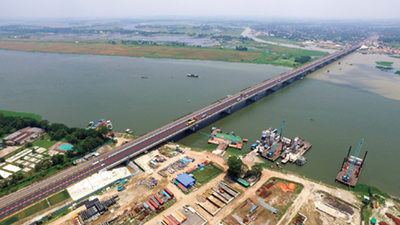
The 2nd Gumti Bridge opened on May 25, 2019 supported by Japanese ODA Loan (Photo: Joint venture by Obayashi Corporation, SHIMIZU CORPORATION, JFE Engineering Corporation, and IHI Infrastructure Systems Co., Ltd.)
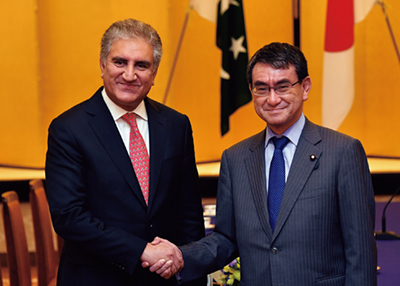
Former Foreign Minister Kono meeting with Foreign Minister Qureshi of Pakistan upon his visit to Japan (April 2019)
Regarding India, a key player in South Asia, the leaders of Japan and India make mutual visits to each other’s country, and Japan promotes cooperation in a wide range of fields based on the “Special Strategic and Global Partnership.” These include economic cooperation as well as cooperation in the fields of politics and security, economy, and academic exchanges. In recent years, India has been the largest recipient of Japan’s ODA loans, and Japan has provided assistance to India for the development of economic and social infrastructure, especially in the fields of electric power and transport, which will contribute to enhancing connectivity and strengthening industrial competitiveness. On top of this, as part of supporting its sustainable and inclusive growth, Japan is providing support to the forestry sector, which is instrumental in afforestation and improving livelihoods, and to the health sector, which will contribute to improving health and medical care services for women, children, and others.
During the Prime Minister Modi’s visit to Japan in 2018, the two countries exchanged notes on the provision of ODA loans for a total of seven projects, including the construction of the Mumbai – Ahmedabad High Speed Rail (MAHSR). In 2019, the two leaders held meetings on the occasion of the Eastern Economic Forum in Vladivostok in Russia and the ASEAN Summit Meeting in Bangkok, Thailand, and reconfirmed their collaboration on these projects. If the high-speed rail development plan is realized, it is expected to shorten the travel time between Mumbai and Ahmedabad, which is currently at least seven hours by express train, to two hours, and the train fee is expected to be roughly half of that of the corresponding airfare. Thus, Japan’s ODA plays a significant role in the growth of India, through assistance in a variety of fields, including infrastructure development, measures to combat poverty, development of the investment environment, and human resources development, among others.
With regard to Bangladesh, where there has been remarkable growth and an increase in the number of Japanese companies operating business in recent years, Japan seeks to further advance the Japan-Bangladesh Comprehensive Partnership and promote development cooperation under the Bay of Bengal Industrial Growth Belt (BIG-B) initiative. The three pillars of the initiative are: (i) Development of economic infrastructure, (ii) Improvement of the investment environment, and (iii) Enhancing connectivity. In May 2019, when Prime Minister Hasina of Bangladesh visited Japan, Prime Minister Abe stated that “Japan will continue to support Bangladesh in its efforts to achieve the SDGs and realizing its vision of becoming a middle-income country by 2021.” Prime Minister Abe also expressed his expectations for the advancement of the BIG-B initiative, as well as for the expansion of the exchanges of people and the further promotion of trade and investment between the two countries. Based on these agreements between the two leaders, in May and June 2019, Japan and Bangladesh signed and exchanged notes concerning the provision of ODA loans for a total of five projects: “Matarbari Port Development Project (I),” “Dhaka Mass Rapid Transit Development Project (Line 1) (I),” “Matarbari Ultra Super Critical Coal-Fired Power Project (V),” which are to contribute to enhanced connectivity within Bangladesh and the development of economic infrastructure, “Foreign Direct Investment Promotion Project (II),” and “Energy Efficiency and Conservation Promotion Financing Project (Phase 2).” In addition, Japan provided assistance to Bangladesh to support the displaced persons from Rakhine State in Myanmar and their host communities, with approximately ¥4.1 billion for health and medical care, water, food and nutrition, the environment and infrastructure, governance, and education in 2019 (see the columns “Bangladesh: Humanitarian Assistance Program for People Fleeing Myanmar”, and “Bangladesh: Project for Livelihood Support to Bangladeshi Smallholder Farmers and Food Assistance to Displaced People from Myanmar”).
Sri Lanka, which is located in a strategic position along sea lanes connecting Asia with the Middle East and Africa, has traditionally been a country that is friendly toward Japan. Japan is working on strengthening cooperation between the two countries, particularly in the fields of enhancing connectivity and maritime matters, toward the realization of a “Free and Open Indo-Pacific.” Furthermore, the two countries exchanged notes on the provision of ODA loans amounting to approximately ¥30 billion, which will enable the introduction of the first new transport (LRT: light rail transit) system in Sri Lanka in March 2019. Moreover, after Sri Lanka was hit with a series of terrorist bombings in April 2019, Japan announced its intention to provide assistance to improve Sri Lanka’s capacities in the area of counter-terrorism and public safety, including the decision to extend grant aid of ¥1 billion to provide counter-terrorism equipment.
In addition, Japan will continue to provide support in the field of infrastructure development, including transportation networks such as roads and ports as well as electric power infrastructure. This support contributes to quality economic development in Sri Lanka as well as to improvements in the business environment for Japanese companies operating in the country. Moreover, considering Sri Lanka’s history of internal conflict and the current situation of increased disparity, Japan will also continue to carry out cooperation that helps national reconciliation and provide assistance to cope with natural disasters, including livelihood improvement and industrial development with a focus on the agricultural sector for regions that are lagging behind in development.
The Maldives, like Sri Lanka, is located in a strategic position along the sea lanes of the Indian Ocean and holds geopolitical importance for Japan. Former Foreign Minister Kono visited the Maldives in January 2018, and Foreign Minister Shahid of the Maldives visited Japan twice, in June and December of the same year, soon after the inauguration of the current administration. The two ministers held Foreign Ministers Meetings and agreed that they would cooperate toward the realization of a “Free and Open Indo-Pacific.” Based on this policy, in 2019, it was decided to extend grant aid of 500 million yen respectively for the provision of disaster risk reduction equipment (fire boat, landing craft boat, etc.) to strengthen the Maldives’ capacity for dealing with natural disasters and fires as well as for the provision of related equipment (police vehicles, liquid inspection apparatus, etc.) to build capacity for dealing with counter-terrorism and public safety. It was also decided to dispatch a macroeconomic and fiscal policy advisor to contribute to enhancing the Maldives’ fiscal policies and its ability to implement these policies.
Pakistan plays a vital role in the international community’s efforts to eradicate terrorism. Japan has thus far provided Pakistan with support for improving its capabilities of security at airports and ports, as well as support for the people that were internally displaced as a result of military operations to eliminate terrorists. Japan is also implementing support to strengthen border control capacity with respect to illegal drug trafficking and international organized crime, and support to provide equipment and products in the fields of peacebuilding, and counterterrorism. Furthermore, Japan also provides support in the field of healthcare, such as the procurement of vaccines needed to eradicate polio in Pakistan. In April 2019, on the occasion of Foreign Minister Qureshi’s visit to Japan, in the presence of Foreign Minister Qureshi and former Foreign Minister Kono, notes on grant aid for two projects were exchanged: the extension of intensive care for maternal and child healthcare, and the provision of cargo inspection equipment to reinforce counter-terrorism at inland logistics bases.
With regard to Nepal, which has a traditional friendship with Japan, the relationship between Japan and Nepal was further strengthened and advanced through the visit to Japan by Foreign Minister Gyawali in November 2018, the visit to Nepal by former Foreign Minister Kono in January 2019, and the visit to Japan by President Bhandari in October 2019. Moreover, direct flights between Kansai International Airport and Kathmandu were resumed in August 2019 for the first time in 12 years, and have promoted people-to-people exchange between Japan and Nepal.
Concerning assistance to Nepal, in the aftermath of the major earthquake that struck the country in 2015, Japan implemented Emergency Grant Aid amounting to $14 million (¥1.68 billion) through eight international organizations. Moreover, to assist Nepal’s medium to long-term reconstruction process, Japan is implementing an assistance package, on a scale total around $260 million (over ¥32 billion) toward rebuilding a resilient Nepal, focusing on rebuilding houses (approximately 60,000), schools (approximately 240), and public infrastructure. Japan is also providing a range of technical support to reduce the damage from earthquake disasters. Furthermore, to support Nepal’s efforts in consolidating and developing its democracy through the new Constitution, Japan is providing support to improve the governance capacity of the central and local governments, as well as to reflect the needs of residents, including the socially vulnerable, in government policies. In addition, Japan has provided funds in support of the School Sector Development Plan that the Government of Nepal launched to narrow gaps in children’s academic abilities and access to education among regions and ethnic groups. Japan has also provided support for the Human Resource Development Scholarship Project by covering the tuition and other costs required for young government officials from Nepal to obtain degrees in Japanese graduate schools.
Furthermore, Japan has built good relations with Bhutan since the establishment of diplomatic relations in 1986, and celebrated the 30th anniversary of diplomatic relations between the two countries in 2016. In October 2019, His Majesty Jigme Khesar Namgyel Wangchuck, King of Bhutan, visited Japan for the second time since 2011 to attend the Ceremony of the Enthronement of His Majesty the Emperor at the Seiden (State Hall), and held a meeting with Prime Minister Abe. Moreover, the relationship between the two countries has deepened in recent years, with Their Imperial Highnesses Crown Prince and Crown Princess Akishino and Prince Hisahito of Akishino taking a private trip to Bhutan in August of the same year. Japan’s development cooperation toward Bhutan serves as the foundation for friendly relations between the two countries. As such, Japan has been providing support while respecting Bhutan’s national development plan that focuses on the country’s fundamental philosophy of Gross National Happiness (GNH). Consequently, this support has achieved steady results, especially in fields such as the improvement of agricultural productivity, development of economic infrastructure such as road networks and bridges, and human resources development. In June 2019, Japan and Bhutan signed an Exchange of Notes on “the Project for Human Resource Development Scholarship,” which is a grant aid project that covers the tuition and other costs required for young government officials of Bhutan to obtain masters or doctoral degrees. This assistance not only contributes to the development of Bhutan, but also to the nurturing of human resources for strengthening good relations between Japan and Bhutan.
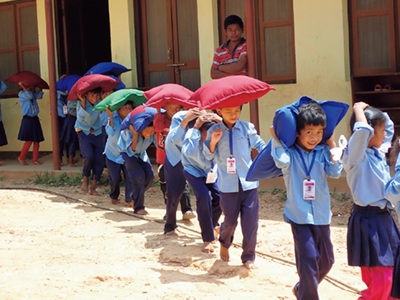
As part of the Grant Assistance for Japanese NGO Projects to strengthen disaster risk reduction, children are evacuating to the schoolyard while protecting their heads with the seat cushions that they use in the classroom in an evacuation drill held in Kalika Primary School in Sindhupalchok District in Nepal (Photo: ChildFund Japan)
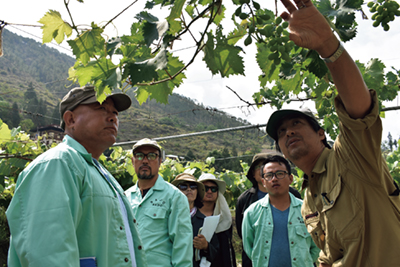
A JICA expert teaching researchers on cultivation management skills for grapes in the garden of the Agriculture Research and Development Center Bajo in Wangdue Phodrang District in Bhutan (Photo: JICA)
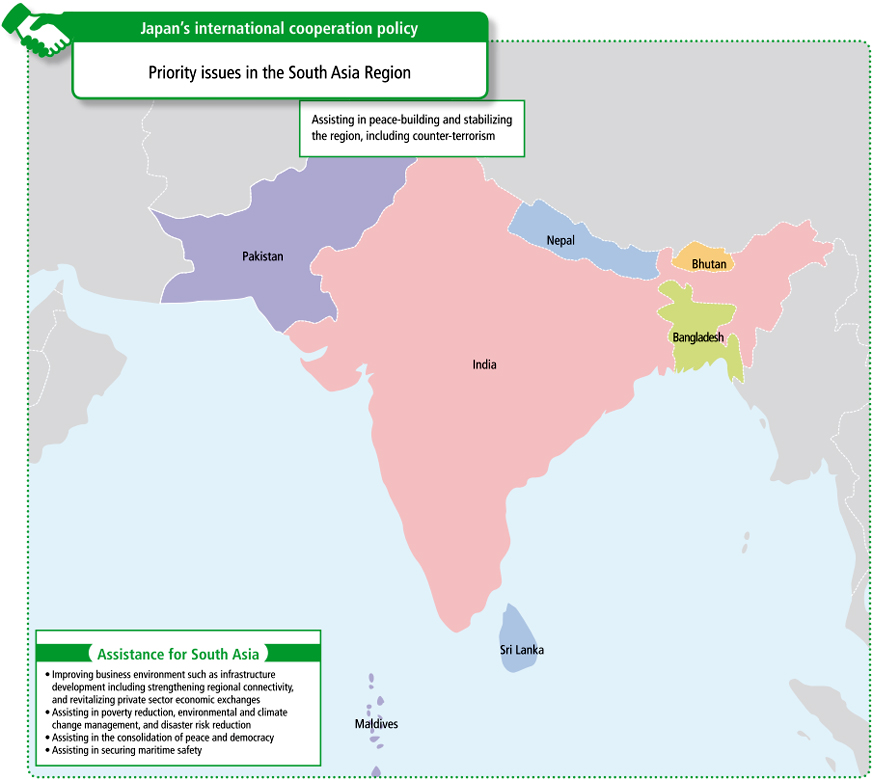
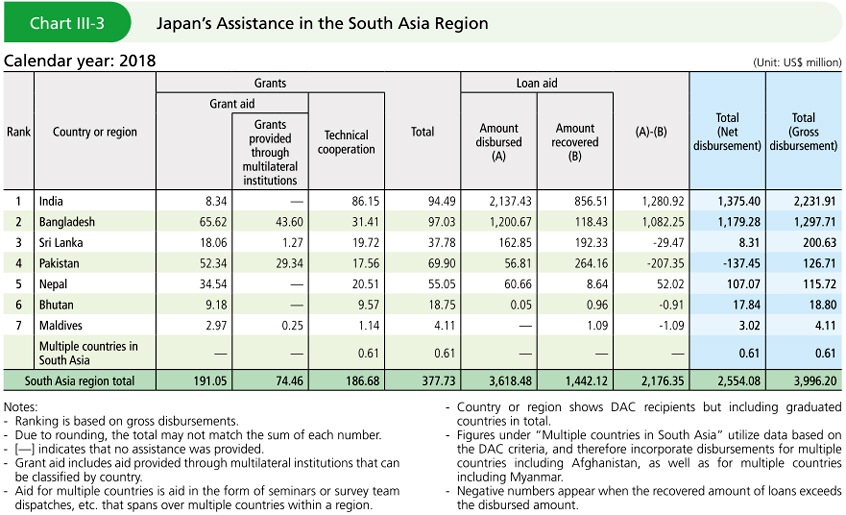
- Note 5: Source: World Bank website.
Population: https://data.worldbank.org/indicator/SP.POP.TOTL?locations=8S
Poverty rate: https://www.worldbank.org/en/news/press-release/2018/09/19/decline-of-global-extreme-poverty-continues-but-has-slowed-world-bank
